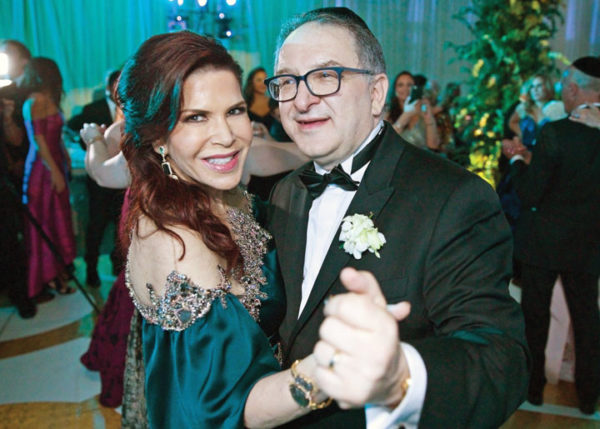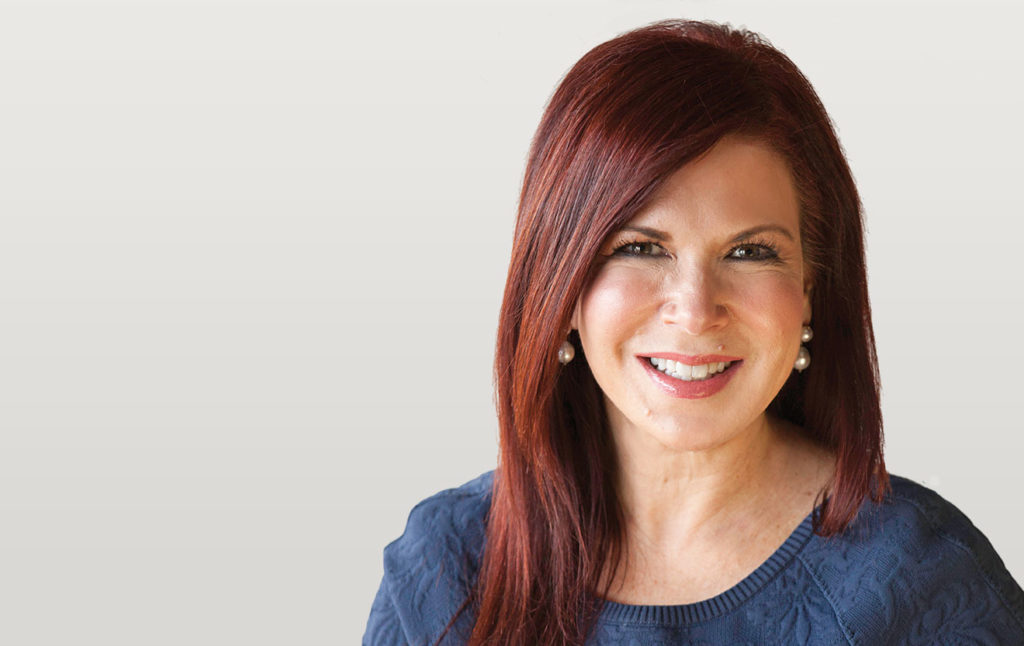Photos courtesy of Vivan Bucay, MD
For Vivian Bucay, MD, a dermatologist diagnosed with advanced melanoma, the road to remission was anything but a straight path. She got there by acting quickly and taking advantage of every tool available at the time.
By Lorraine Glennon (with additional reporting by Mark Teich)
“I just thought it was some sort of irritation,” says Vivian Bucay, MD, of the whitish residue that, back in 2006, she occasionally noticed inside her belly button or on dark clothing. She was tempted to shrug it off. Aside from the slight flakiness, she had no symptoms or visible marks or lumps on her skin. But as a dermatologist with a thriving San Antonio practice, Dr. Bucay, then 45 and the mother of three daughters, had been trained to check out anything even slightly “funky.” So more out of “academic curiosity than anything else,” she asked her physician’s assistant to help with a routine shave biopsy of the area.
The pathologist who looked at the tissue called her on May 10, 2006 to say the biopsy revealed amelanotic melanoma, an uncommon type of dangerous skin cancer that lacks the characteristic dark color of most melanomas. When she asked the pathologist which patient he was calling about, Dr. Bucay was shocked to learn that she was the patient. She wondered whether the partial biopsy had produced a false positive. But further testing confirmed the diagnosis: While not metastatic, her tumor (invisible because it was so deeply embedded in her belly button) was not only unpigmented, but also large (3.3 mm) and ulcerated, putting it at high risk for spreading.
Her surgeon removed the tumor and a wide margin of tissue and performed a sentinel lymph node biopsy (SLNB). This is done on the first lymph node or nodes to which a cancer will spread. If they are free of cancer cells, generally the rest of the lymph nodes are, too, and surgery ends there. Unfortunately, Dr. Bucay’s SLNB showed melanoma, and she was classified as stage III.
She now faced an agonizing choice of undergoing a complete lymph node dissection, or CLND (also called radical dissection), in which the remaining lymph nodes in her groin would be removed in order to eliminate any cancer in the area and to keep it from spreading. This surgery is somewhat disfiguring and disabling, since it removes a large swath of skin and tissue along with the lymph nodes. It can also lead to complications such as lymphedema, a condition characterized by excessive fluid buildup and swelling. But there was an even more fundamental problem with CLND: There is no definitive proof that it works. For one thing, by the time the procedure is done, microscopic melanoma cells might have already invisibly spread, only to become detectable later.
Dr. Bucay’s other option was simply to “wait and see” if any of the remaining nodes became palpably cancerous. By both temperament and training, however, Dr. Bucay was not a “wait-and-see” person. Just 20 days after her initial diagnosis, she underwent a radical dissection of the groin. “I needed to know if more than one lymph node was involved,” she explains. “And I felt the more cancer you can get rid of, the better.”
Throughout her ordeal, she enlisted the advice and support of friends, family and colleagues, not least her cardiologist husband, Moises Bucay, MD. But perhaps the most eloquent argument in favor of an aggressive approach to managing her cancer came from the oncologist to whom she had now entrusted her case, Ronald Drengler, MD, of San Antonio’s START Center for Cancer Care. Dr. Drengler had already recommended the immunotherapy interferon alfa-2b, then the only approved treatment for stage II and III melanoma patients, as an “adjuvant,” or additional, therapy to her radical dissection. But the ante was upped when two of the 28 lymph nodes removed in the surgery were found to be cancerous.
“I remember walking down to sublevel two of the hospital to view her slides after the radical dissection,” Dr. Drengler says. “When I saw the way her melanoma was growing and spreading, despite what should have been the fortress of her natural immune defenses, I got chills up and down my spine. This melanoma was a really bad actor.” Interferon alone, he realized, would not suffice; they would need to seek out additional options.
“As Dr. Drengler was explaining all this, I asked him, ‘Are you afraid I’m going to die?’” Dr. Bucay remembers. “And he looked me in the eye and said, ‘Yes, I’m afraid you’re going to die.’ I think until then I hadn’t fully grasped how serious it was. I told myself, ‘This is not how you are going to die!’” For years, Dr. Bucay had been preaching nonstop to her patients about staying out of the sun and wearing sun protection — and practicing what she preached. “I still do,” she says. “It’s so important, but here I was with melanoma in a place that was totally not exposed to sunlight. The irony was just too much.”
A Promising Therapy Goes on Trial
With an official designation of stage IIIB cancer, Dr. Bucay’s chances of survival over 10 years were roughly 40 percent. She spent the six-week recovery period during the summer of 2006 after her radical dissection exploring treatment options around the country. As a nationally known dermatologist herself and part of a high-profile medical couple, she admits she had some advantages rarely available to her own patients. These included plentiful connections across the medical community, rapid access to doctors and scientists and speedy test results. On the other hand, unlike ordinary patients, she understood too much to comfort herself with false optimism: “As a dermatologist, I knew the prognosticators, and I had all the bad ones. So I worried constantly about my daughters.”
“During the dark times,” Dr. Bucay recalls, “I promised my husband I wouldn’t die. And I promised myself that I would dance at my daughters’ weddings.”
The experts she consulted recommended that she start with interferon alfa-2b but enroll in any clinical trial she qualified for. There were none. But Patrick Hwu, MD, then chair of melanoma medical oncology at The University of Texas MD Anderson Cancer Center, mentioned that Jeffrey S. Weber, MD, an oncologist at the USC Norris Comprehensive Cancer Center in Los Angeles, would soon launch a trial of an exciting new drug for high-risk melanoma.
That drug, developed by immunologist James P. Allison, PhD, then at University of California, Berkeley (who, along with Japanese immunologist Tasuku Honjo, MD, PhD, won the 2018 Nobel Prize in Physiology or Medicine for this breakthrough work), was called ipilimumab. It heralded an entirely new class of treatments called checkpoint blockade therapies, so named because they block certain proteins that keep the immune system in check. These checkpoints rein in the disease-fighting T cells to keep them from attacking the body itself when there is no disease to go after. Because melanoma and other cancer cells can often evade immune detection, T cells won’t attack them. By blocking one of these immune checkpoints, ipilimumab releases the brakes on the immune system, unleashing battalions of T cells to fight the cancer.
Dr. Bucay signed up to enroll, but she was unwilling to delay treatment while she awaited notification of when and if the trial would start. So she began the interferon therapy, which consisted of four weeks of daily high-dose intravenous treatment, followed by 11 months of home injections. She had completed the IV treatment and was two months into the home injections when she got word that the ipilimumab trial was launching.
She immediately stopped the injections and in October 2006 began commuting back and forth from Texas to Los Angeles every two weeks for the clinical trial of the checkpoint blockade therapy. Contrary to her expectations, she felt great and had no symptoms except for a rash she developed all over her body. Dr. Weber called it a “good rash,” she explains, because it was associated with a positive response to the treatment. “I worked normal hours and was busy planning my daughter’s bat mitzvah.”
Against All Odds
In early January 2007, having completed her second dose of ipilimumab (out of seven total), Dr. Bucay celebrated her mother-in-law’s 70th birthday. She was feeling fine and justifiably optimistic, looking forward to the bat mitzvah in a couple of weeks. Taking advantage of a rare snow day in her practice, she decided to get some scans done that the trial required. She recalls: “Literally 15 minutes later, the doctor phoned and said, ‘Hi, how are you feeling?’ And I said, ‘Really good.’ She asked, ‘Any cough?’ No. ‘Any fever?’ No. ‘Any shortness of breath? Weight loss?’ I said, ‘No, I’m still the only cancer patient who doesn’t lose weight.’”
Dr. Bucay remembers the doctor laughed, paused and then said, “Well, you’ve got bilateral metastases all over your lungs. They look like snow globes.” For Dr. Bucay, the moment was pure déjà vu: “That was the second time, after the day of my original diagnosis, that I felt all the blood just drain out of me.”
The news was doubly devastating because it also meant she had “failed” the trial and would be disenrolled. And yet she was convinced the ipilimumab was working. She immediately went to Los Angeles to confer with Dr. Weber. “In my pseudo-knowledge, I started rationalizing,” she says. “How can we be sure these are metastases? The rashes are side effects, so maybe they’re in my lungs and that’s why the scans lit up.” She all but begged Dr. Weber to ignore the scans and let her continue the therapy, but he and Dr. Drengler insisted on a biopsy. Keeping the procedure secret from everyone but her husband, Dr. Bucay had the biopsy two days after the bat mitzvah. “When I woke up, my husband told me it was, in fact, melanoma.” The metastasis reclassified her cancer as stage IV. According to FDA rules, she was no longer eligible for the clinical trial.
Dr. Bucay’s chances of 10-year survival were now about 3 percent. But she couldn’t give in to despair. “During the dark times, I promised my husband I wouldn’t die,” she says with a catch in her throat. “And I promised myself that I would dance at my daughters’ weddings.” Once again, she plunged into discussions with Dr. Drengler, and this time he and her husband urged her to visit Steven A. Rosenberg, MD, chief of surgery at the National Cancer Institute in Bethesda, Maryland. On February 27, 2007, Dr. Bucay was on her way to Bethesda.
For more information about many of the medications and procedures involved in Dr. Bucay’s medical journey, visit our Treatment Glossary.
She and Dr. Rosenberg settled on two treatment options: Interleukin-2 (IL-2) immunotherapy, then the only FDA-approved treatment for stage IV melanoma, followed by another clinical trial, of a revolutionary immunotherapy technique called autologous T-cell transfer therapy. In this still-experimental procedure, T cells are extracted from the patient, genetically strengthened and cultured in the lab, and returned in massive amounts to the patient. Enrollment in the trial could happen only after a patient had failed the IL-2 therapy, but given IL-2’s low success rate — only 6 percent of patients using it go into remission — none of the doctors, including Dr. Bucay, held high hopes for it. So they made the necessary plans for the clinical trial.
Interleukin-2, delivered intravenously over a five- to six-day period, can have very toxic effects, so it was administered under close supervision in an intensive care unit at Methodist Hospital in San Antonio. For her first course, which produced debilitating chills, flulike symptoms and massive fluid retention, Dr. Bucay did two one-week cycles, spaced a week apart, in March 2007, and then waited one month before going for scans and assessment by a radiologist.
The April scan brought good news at last: Her lung nodules had shrunk by 60 percent. Though only a partial response, this was more than enough to warrant a second, equally grueling course of IL-2, followed by another monthlong waiting game. “During this time, there was not a day that I did not pray for membership in the ‘6 percent club’ of complete responders,” Dr. Bucay says.
Almost immediately after her CT scan on August 1, 2007, the doctor led Dr. Bucay, her husband and her best friend, Elizabeth Leyendecker (now her office manager), into the radiology reading room and showed them the scan. The nodules in her lungs had completely disappeared. Not a trace of cancer remained in her body. “I can barely even describe how I felt,” Dr. Bucay recalls. “It was utter ecstasy.”
As a newly inducted member of the “6 percent club,” she never had to enter that second clinical trial. At press time in May 2020, it has been 14 years and counting since her diagnosis. “I’m still counting,” she says. “And I did dance at my oldest daughter’s wedding in 2017, and was the first to hold my grandson immediately after his birth in 2018.”

A Promise Kept: Drs. Vivian and Moises Bucay dance at their daughter’s 2017 wedding.
Anatomy of a Miracle
It would be easy to conclude that IL-2 worked when nothing else did. And that is certainly possible. “A small percentage of patients do have complete responses to IL-2,” says Dr. Weber, now deputy director of NYU Langone’s Laura and Isaac Perlmutter Cancer Center in New York City.
But Dr. Bucay and Dr. Drengler believe that IL-2 was merely a final, albeit vital, part of a treatment “cocktail,” a multipronged effort that over 13 continuous months kept adding to Dr. Bucay’s immune response and chipping away at the cancer until it was defeated. Even so, they single out ipilimumab as the most crucial factor in her durable remission.
“I always thought the drug was working,” she says. She also theorizes that the disease didn’t necessarily advance while she was on ipilimumab but rather was exposed by it. By kick-starting an immune system that had been sleeping, she explains, the drug essentially drew those invisible cancer cells out of hiding so that her T cells could attack them.
Indeed, this is how checkpoint blockade therapies are now known to work. (Ipilimumab, nivolumab, pembrolizumab and combinations are now FDA-approved or being studied as treatments for unresectable and metastatic melanoma and as therapies supplemental to surgery.) Dr. Bucay was treated so early in the development of these therapies, however, that researchers had not yet discovered that they can take a while to kick in but then continue to strengthen patients’ immune systems even after the therapy has ended.
“We’ve learned that there can be late responders to ipilimumab,” says Dr. Drengler. “We’ll never know exactly how important it was to Vivian’s outcome, because we switched to interleukin after the positive lung biopsy. But ipilimumab was still in her system, and it unquestionably gave the interleukin a boost.”
Perhaps most significant for the future of cancer treatment is the fact that all of these therapies, just like interferon alfa-2B, interleukin-2 and many other drugs before them, originated in clinical trials — including the one that Vivian Bucay “failed” back in 2006. Who would have guessed then that a drug that ostensibly didn’t work would be instrumental in saving her life?
In Praise of Clinical Trials
Although they may never know for sure, Vivian Bucay, MD, and her primary oncologist, Ronald Drengler, MD, believe that her participation in a clinical trial for ipilimumab in 2006 and 2007, abbreviated as it was, was an essential part of her “durable remission” from stage IV melanoma.
Dr. Bucay is a fervent supporter of clinical trials. “I tell my patients that even if something is new and untested, there wouldn’t be a study unless there was some research indicating it has promise. If you have advanced cancer and there’s something to try, go for it. The worst that can happen is it doesn’t work. What’s far worse is if something that might have helped doesn’t because you didn’t try.”
Whether a patient has advanced cancer, a nonterminal condition or isn’t yet sick (many trials test preventive treatments), Dr. Bucay applauds all trial participants for the scientific and medical progress they advance. “Regardless of what a trial does for you, it does something for future generations. It may even save their lives.” To search for U.S. trials, visit clinicaltrials.gov.
Lorraine Glennon is a writer and editor based in Brooklyn. She writes on health, politics, books, personal finance, art and architecture for online and print publications.






